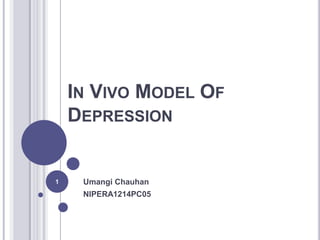
In vivo model of depression
- 1. IN VIVO MODEL OF DEPRESSION Umangi Chauhan NIPERA1214PC05 1
- 2. DEPRESSION Depression is defined as disorders of mood rather than disturbances of thought or cognition; it may range from a very mild condition, bordering on normality, to severe (psychotic) depression accompanied by hallucinations and delusions. Worldwide, depression is a major cause of disability and premature death. 2
- 3. SYMPTOMS Emotional symptoms: misery, apathy and pessimism low self-esteem: feelings of guilt, inadequacy and ugliness indecisiveness, loss of motivation Biological symptoms: retardation of thought and action loss of libido sleep disturbance and loss of appetite TYPES o Unipolar depression o Bipolar depression 3
- 4. THEORIES OF DEPRESSION 1. Monoamine theory: • Monoamine hypothesis, proposed by Schildkraut in 1965, which states that depression is caused by a functional deficit of monoamine transmitters at certain sites in the brain, while mania results from a functional excess i.e. NA,5-HT. 2. Neuroendocrine mechanism: • Increase cortisol, growth hormone concentration is reduced and prolactin is increased. • But these changes are nonspecific. 3. Neuroplasticity: • Depression is associated with neuronal loss in the hippocampus and prefrontal cortex. • Antidepressant therapies of different kinds act by inhibiting or actually reversing this loss by stimulating neurogenesis. 4
- 5. ANIMAL MODELS OF DEPRESSION Despair swim test Tail suspension test in mice Learned helplessness in rats Muricide behaviour in rats Potentiation of norepinephrine toxicity Reserpine induced hypothermia 5
- 6. DESPAIR SWIM TEST Mice or rats forced to swim in a restricted space from which they cannot escape are induced to a characteristic behavior of immobility. Method: Rats placed in the cylinders for the first time Initially-They are highly active After 2-3 min-Starting of immobility or floating After 5-6 min-Remain immobile Test drugs or standard are administered one hour prior to testing. Evaluation Duration of immobility is measured in controls and animals treated with various doses of a test drug or standard. 6
- 7. TAIL SUSPENSION TEST IN MICE The immobility displayed by rodents when subjected to an unavoidable and inescapable stress has been reflect depressive disorders in humans. Method Male Balb/cJ mice weighing 20–25 g are used Animals are treated with the test compounds or the vehicle by i.p. injection 30 min prior to testing. Mice are suspended on the edge of a shelf 58 cm above a table top by adhesive tape placed approximately 1 cm from the tip of the tail. The duration of immobility is recorded for a period of 5 min. 7
- 8. Evaluation The percentage of animals showing the passive behavior is counted and compared with vehicle treated controls. Using various doses, ED50 values can be calculated. 8
- 9. LEARNED HELPLESSNESS IN RATS Animals exposed to inescapable and unavoidable electric shocks in one situation later fail to escape shock in a different situation when escape is possible Method Learned helplessness is produced in male Sprague- Dawley rats (300 g) by exposure to electric shock (0.7 mA) for 1 h on a schedule of 10 s of shock/min. The platform is not available during training. After giving test drug,the shock is initiated (0.4 mA) Shock is terminated in 10 s if the animal has not escaped onto the platform by this time. 9
- 10. If an escape response occurred, the animal is allowed to remain on the platform for the duration of 10 s, then returned to the grid floor. Ten such trials with an interval of 20 s are given. Evaluation A drug is considered to be effective, if the learned helplessness is reduced and the number of failures to escape is decreased. 10
- 11. MURICIDE BEHAVIOUR IN RATS A selective inhibition of mouse-killing behavior in rats by antidepressants. Method Male SD rats (300–350 g) are isolated for 6 weeks in individual cages. One mouse is placed into the rat’s cage. About 10 to 30% of rats kill the mouse by biting the animal through the cervical cord. Only rats consistently killing mice within 5 min after presentation are used for the test. Drugs are injected i.p. to the rats before the test. Mice are presented 30, 60 and 120 min after drug administration. 11
- 12. Evaluation Failure to kill a mouse within 5 min is considered inhibition of muricidal behavior. The ED50 is calculated(dose which inhibits mouse killing in 50% of the rats.) Modifications Injections of 5,7-dihydroxytryptamine into the lateral hypothalamus increased mouse-killing behavior in rats 12
- 13. POTENTIATION OF NOREPINEPHRINE TOXICITY Antidepressants block the re-uptake of biogenic amines into nervous tissue. In this way, the toxic effects of norepinephrine are potentiated. Method Male NMRI mice (22–25 g) are randomly assigned to test groups of 10 subjects. The test drug, the standard or the vehicle are given orally 1 h prior to the s.c. injection of the sublethal dose of 3 mg/kg noradrenaline. Evaluation The mortality rate is assessed 48 h post-dosing. ED50,or dose which causes death of 50% of the treated subjects,is calculated 13
- 14. RESERPINE INDUCED HYPOTHERMIA Depletion of biogenic amines (noradrenaline, 5- hydroxytryptamine, dopamine) in the brain induces not only catalepsy and ptosis but also hypothermia in rodents. The decrease of body temperature induced by reserpine is antagonized by antidepressants, MAO-inhibitors and central stimulants. Method Groups of male NMRI mice (19–21 g body weight)are used On the day before testing, they are dosed with 2 mg/kg reserpine s.c. 14
- 15. Eighteen hours after reserpine administration, the animals are placed into individual cages. The initial rectal temperature is determined by insertion of an electronic thermometer Following administration of the test compound (either i.p. or p.o.), the rectal temperature is measured again at 60 min intervals for 7 h. Evaluation Rectal temperature is recorded every hour. The difference in temperature from vehicle controls is calculated for each time and the maximal difference is scored. 15